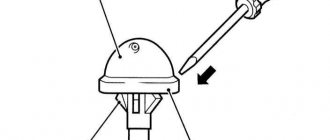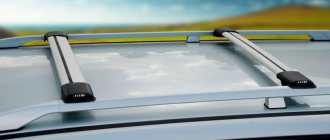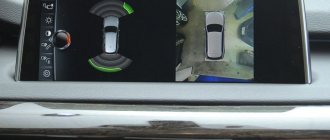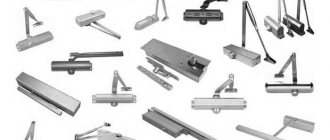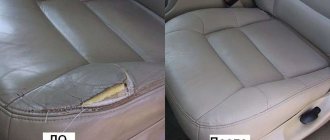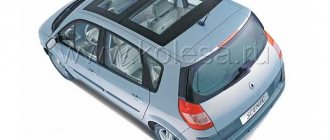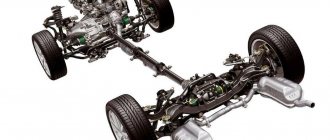What is a deflector - a wind deflector for a car
Deflector translated from English means cut-off device. This accessory is a plastic visor that is installed in the upper part of the side opening of the car, as well as on the hood.
The deflector cuts off air flows that bring dirt and dust into the car interior. It also protects the windshield from dirt from the front side, where dirt from outside often penetrates into the car.
By installing the deflector on the hood and windows, you can be sure:
- dead insects will not stick to the hood,
- debris flying towards the car (stones and gravel from roads) will change its trajectory and be diverted away from the hood and glass,
- When opening a window during rain, you don’t have to worry – water won’t get into the car’s interior.
An example of installing a deflector on a car body.
Cars are not equipped with deflectors as standard. This is due to the fact that installing a deflector reduces the streamlining of the body, resulting in an increase in air resistance.
This in turn leads to increased fuel costs. In this regard, each driver decides for himself whether he needs deflectors and whether he is ready for additional gasoline costs.
Choose deflectors from trusted manufacturers.
How to avoid installation problems
To avoid unexpected surprises during the installation of wind deflectors, take note of 5 simple rules:
- Change windshields only in dry weather or in a dry, well-ventilated garage.
- When purchasing a set of cut-offs, try on several pairs for your car windows and choose those that fit as closely as possible and do not block the view of the rear mirror.
- Install wind deflectors with an assistant - an extra pair of hands will help you complete the task faster and achieve a high-quality result.
- If the air temperature is less than +18...+20°C, do not be lazy and warm up the joints of the parts with a hair dryer.
- After attaching the fairings, do not use the car for at least a day, including do not wash it.
Gluing and removing the windshield is not as difficult as it seems at first glance. The key to success lies in the correct selection of fairings specifically for your car model and depending on a couple of circumstances: the presence of an assistant, suitable weather and accuracy.
First, let's figure out what a deflector is. Most often, deflectors are called wind deflectors. Translated from English, deflector means cut-off device. Deflectors are not ordinary accessories for making your car look interesting; they have other useful functions. They are designed to provide additional comfort and improve aerodynamics.
How to glue side window deflectors to a car
The advantages of using this adhesive material include ease of use, since there is no need to drill holes or use additional fasteners. The car doors remain undamaged.
Gluing windshields to the car - instructions
For gluing you will need the following materials:
- a set of deflectors (it is better to purchase original versions for your model, after trying them on the door or hood and making sure that they fit - the deflectors should not obstruct your view),
- construction hairdryer
VIDEO INSTRUCTIONS Operating procedure:
- Remove all dirt from both surfaces and decontaminate them with napkins, which usually come with windshields. To do this, holding the device in your hands, peel back the film covering the outer layer at both ends. You can heat the adhesive strip, as well as the place to install the deflector, with a hair dryer. This will improve the adhesive properties and increase the service life of the windshields.
- Attach the windshield to the installation site and glue the edges. Make sure there are no gaps. If they are not there, then pull the protective film from under the deflector and firmly glue the device. It is more convenient to do this together: one person will hold the product, and the second will remove the film and press the windshield to the surface. Working together, you can adjust the position of the deflector at the very beginning of installation.
- Press down on the windshield and hold for five minutes.
All work must be carried out in a warm room, the temperature should not be lower than +10C. On average, gluing the windshield takes no more than 10 minutes.
We glue the deflector to the car door
If you purchased the push-in options, installing them will be even easier.
To do this you need:
- Roll down the windows.
- Insert the products into the glass groove under the machine door frame. If the shape of the deflector is not suitable, the windshield needs to be slightly bent. The windshields are held in the front doors by being installed in a spacer. In the rear doors they are taped around the perimeter with double-sided tape.
It is worth keeping in mind that cheap windshields damage the protective film of the glass, since such manufacturers do not sharpen the mounting edge properly and a tight edge will not allow the car window to close.
Insert option for glass
There are not only adhesive options on the market, but also plug-in ones. They are designed for fastening under the rubber seals on car doors. Many are dissatisfied with these deflectors, since initially in factories car doors are not designed for such manipulations, so the foreign body becomes unnecessary, looks bad and even breaks.
But the installation process itself is quite simple. You just need to lower the windows and insert the deflectors under the sealing tape. Be careful when closing the windows for the first time so as not to break anything.
The question of how to glue windshields to a car requires certain knowledge. There are no identical models or similar situations; each installation should be treated as if it were the first, in order to carry out the process with the highest possible quality, and so that the deflectors serve the car owner for a long time and reliably!
Vladimir Maksimov
The main active force underlying the operation of the chimney and exhaust ventilation is draft. This is a physical phenomenon based on the difference in pressure at the top and bottom of the pipe. With the correct calculation of its length and diameter, the system will always have good draft, which removes the combustion products of solid fuel to the outside, and also ensures the supply of fresh air.
But in practice, the chimney/ventilation does not always work efficiently enough. To increase performance and enhance traction, additional devices are used, including deflectors.
This is a metal cap made of galvanized or stainless steel that fits onto the top of the chimney or roof vent unit.
The deflector's operation is based on Bernoulli's physical law, according to which, when the lumen of the exhaust pipe narrows, the air flow speed increases. As the flow rate increases, the exhaust gases become rarefied, creating a low-pressure area that produces draft. According to calculations, installing a deflector on a chimney increases the efficiency of the heating system by 20-25%.
The deflector consists of several elements - a metal pipe that is installed on the chimney, a diffuser, an outer ring and a protective element (umbrella).
Important! The design of the deflector is quite simple, and if necessary, you can make it yourself. This requires a sheet of galvanized or stainless steel and fasteners to connect the components together. But you can also purchase ready-made designs in accordance with the diameter and location of the chimney.
Correct selection of device
First of all, when choosing window deflectors, you need to remember that they are purchased exclusively in accordance with the specific brand and type of vehicle. There are no universal models, because the design of the body and windows of each car model is unique. The main criterion by which all devices are classified is the method of attachment to the car window. On this basis, the following categories are distinguished:
- Side window deflectors with a screw connection, for installation of which it is necessary to damage the hood and door frames by drilling holes in them;
- Devices that are mounted on a double-sided elastic lining treated with an adhesive liquid;
- Combined deflectors. Their design combines several methods of mounting on car windows;
- Side window deflectors, which are attached using special clamps and brackets.
Window deflectors
Units that require drilling holes for installation, thereby compromising the integrity of the car body coating, are becoming less and less popular. The most common installation methods today are the following:
- Glue the device with adhesive tape or insert it under a rubber gasket (used when working with window deflectors);
- Secure the device using clamps, brackets and special adhesive pads.
Installation of the “Vetrovik” deflector
It is very easy to install such a device with your own hands. Once everything necessary for installing the deflector has been correctly selected and prepared, you can begin to work. First of all, you need to carefully examine the surface where the installation will take place. It is advisable to use a degreaser. For polishing, it is best to use a technical solvent, rags, as well as paraffin and wax-containing mastic. It is best to glue the side window deflectors when the weather is dry outside and the body temperature is not lower than eighteen degrees. Please note that installation work must be carried out simultaneously for both the front and rear windows of the car.
When installing a window deflector, you should adhere to the following algorithm of actions:
Purpose and design of windshields on car windows.
By installing windshields on the side windows of your car, you can immediately solve several problems. By equipping your own car with such an accessory, you will increase the level of comfort when driving in bad weather. Dirt, rain, snowfall and sun will no longer be able to interfere with your riding. After all, by opening the window slightly during a trip, when the weather is rainy and slushy outside, you can calmly ventilate the interior, no longer fearing that drops and dirt will get into you and the interior of your car.
It should be noted that windshields also perform the function of exhaust hood. With this attribute, the car enthusiast will be able to smoke while driving without opening the entire window.
If you are a fan of doing everything with your own hands, then these articles may be useful for you: Choosing and installing a fly swatter on the hood of a car with your own hands, polishing glass with your own hands, Installing parking sensors with your own hands.
Modern windbreakers are distinguished by a particularly durable and, at the same time, lightweight design. Such automotive attributes can easily withstand quite significant dynamic loads. For example, they are no longer afraid of strong water pressure during washing.
How to correctly install side windshields on a car.
Most manufacturers of side deflectors develop their products specifically for specific types and models of cars.
Modern wind deflectors can be divided into two groups based on the method of attaching them to the car body: adhesive and plug-in deflectors.
It must be emphasized that car owners are quite biased towards the first type. This is due to the fact that today it is very difficult to find suitable windbreakers of high quality. However, to the delight of car enthusiasts, quite a lot of attention has recently been paid to the design of the deflector.
However, at the same time, it is worth remembering that there are similar brands of cars for which their installation is simply not provided.
The first stage of installation should be fitting it to the car and checking that the dimensions of the windshield match the car body. To do this, you need to attach the windshield to the mounting location to make sure the sizes are similar. Remember that the windshield should not distract the driver's attention. If these requirements are met, then you can proceed with the actual installation.
Remove dirt and degrease the mounting area
After this, gradually peel off the film and carefully begin gluing. The attached windshield must be pressed tightly for a while.
After this, check the quality of the fastening, but do not overdo it too much.
Installation of the Fly Swatter
Each “fly swatter” always includes several mounting brackets. They may differ slightly in parameters, but they perform the same function. If you want to properly install the “fly swatter” with your own hands, then you need to proceed according to the following scheme:
The process of installing the deflector on the hood
- The hood must be thoroughly washed and wiped dry, after which its front part is degreased using a solvent;
- It is necessary to install brackets on the device and perform fitting;
- The places where the brackets will be attached are marked on the hood;
- The marked areas are covered with special gaskets that protect the paintwork;
- The brackets are mounted on the hood and fixed in a strictly established place;
- “Pads” are attached to the back parts of the devices from which the film is removed (strictly in the place indicated in the instructions);
- The device is mounted in the intended place, the bolts on the brackets are tightened.
Body protection accessories
Do not think that damage from road litter is harmless and is extremely rare. If the car is used and not parked in a garage, its body wears out and experiences harmful effects. Damage to the hood surface will subsequently be marked by a corrosion process. But a more unpleasant situation is when small stones hit the front window. The resulting chip or scratch in sunny weather will make itself felt by refracting light and blinding the driver. If this damage is left unattended, a gradually growing crack will appear on the glass. Thus, delaying restoration will entail more financial costs.
In order to reduce the risk of damage to the front part of the body, special protective devices were developed - deflectors. The design of this part follows the line of the hood edge. With its slightly bent upper part, the deflector prevents the flow of air with abrasive particles and directs it above the hood and windshield. Due to this feature, this protective element is called a “windbreaker”. There are also deflectors to protect the side windows and headlights.
Sometimes some car owners hesitate to install deflectors because they are not sure that they can install them correctly. Knowledge of the rules for fastening them and taking into account some of the nuances that you may encounter during the installation process will help in this matter.
Installation Rules
There are two options for installing the Srelka windshield deflector. The first one is recommended by the manufacturer. The device is mounted on the corner of the front pillar of the car. This is done quite simply:
- clean and degrease the surface of the stand using the alcohol wipe that comes with the kit;
- wait until the alcohol has completely evaporated;
- take the deflector and remove 10-15 cm of the protective adhesive tape from it;
- start gluing the deflector, gradually removing the adhesive tape.
Deflector installation diagram
If necessary, the device can be trimmed, leaving at least 10 cm of the deflector protruding beyond the level of the windshield.
There is another, alternative option, which is much more reliable than the recommended one. To carry out the work you will need:
- crepe tape or any other adhesive tape;
- stationery knife;
- Double-sided tape;
- madeline;
- deflector directly.
The Strelka deflector is an L-shaped rubber profile. To make the installation nice and smooth, you will first need to take some crepe tape and apply it along the edges of the windshield. The gap between the adhesive tape and the side pad should be about a millimeter.
Now you will need to unscrew the three Torx screws on the side of the door and remove the side trim. Remove the adhesive tape from the deflector and, if necessary, straighten its edges using a utility knife. They should be perfectly rounded to the shape of your windshield.
Deflector Arrow on double-sided tape
Stepping back 1 mm from the crepe tape, stick double-sided tape on the other side, which will be used to attach the windshield deflector. Now it can be applied to the tape so that the latter is securely hidden by the rubber strip.
To consolidate the result obtained, you can stick a strip of “Madeline” material on top of the windshield deflector. Due to the fact that the profile is small, it is easy to press it with the side plate that you will install in place. It will avoid friction and eliminate any sounds. When gluing the material, you should not press it close to the top of the deflector, because it will be noticeable close to it.
The result of installing the deflector
After all the manipulations, the side trim can finally be put in place and secured with bolts. Now all that remains is to remove the crepe tape from the windshield, and all that remains is to enjoy the result.
As for their properties, they completely cope with their task. You will forget about swirling water and streaks on the glass. Of course, snow will still get clogged, but the device is quite easy to clean, so there is no need to worry about this.
Drawing conclusions, we can say with confidence that the deflector is a practical device that is indispensable in our climate. Install it on your car and see for yourself!
Installing the deflector on the hood
In order for the deflector to best protect the hood, you should take its choice seriously. It happens that a hastily purchased deflector does not fit the width or shape of the hood. In this case, attempts to adjust it to the desired size by trimming or other manipulations will not lead to the desired effect. It is important to note that for most makes and models of cars, these protective elements are produced separately.
The following guide will help you install the deflector on the hood:
- Remove the protective film from the surface of the deflector and remove the covers from the mounting clips on its reverse side.
- Loosen the stop bolts on the mounting clips by turning them out a little with a Phillips screwdriver.
- Having opened the hood, put the deflector on it so that the edge of the hood passes into the bend of the clip between the thrust bolt and the gasket.
- Align the deflector with the center of the hood and tighten the stop bolts, but only on one side for now.
- Grasping the loose edge, tighten the deflector until it fits snugly against the edge of the hood and tighten the stop bolts.
Deflectors for headlight protection
Car headlights are one of its most expensive components. Damaged optics are quite difficult to immediately replace with new ones, since original samples have to wait a long time after ordering, and analogues may not be suitable. By taking care of the protection of the headlights, you can extend their service life, and for this there are deflectors that preserve the optics of the car.
Such deflectors also fit well into the overall design of the car and they do not affect the quality of lighting. Installation work does not take much time because there is no need to remove the headlights. Plastic fasteners are located in the engine compartment or on the side of the trunk compartment. The deflectors installed on the headlights are able to provide adequate protection from the harmful effects of road conditions and prevent glass optics from chips and cracks.
Installing deflectors on windows
Wind deflectors for windows are a truly useful accessory. They not only protect glass from damage, but also provide passengers with comfort. Not all cars are equipped with a climate control system, so purchasing and installing window deflectors is an inexpensive way to increase comfort in the cabin. These plastic covers, like a visor, protect against raindrops or dirt getting inside through slightly open windows. In addition, in rainy weather it will be possible to provide natural ventilation and thus avoid fogging of the windows.
There are two options for installing window deflectors:
Plug-in - simply installed on the window frame in the glass groove. They are held in place by being clamped with a rubber seal. This can be done like this:
- The window glass is lowered and the rubber sealing tape supporting the glass is removed from the glass groove. (Removed only along the length of the deflector, starting from the side of the rear view mirror).
- The “windscreen” is inserted into the groove and clamped by installing the rubber seal in place.
- It will take some time for the glass to develop and, after grinding in, close tightly.
Adhesive - contain an adhesive layer initially covered with a protective film. Installation of this type of deflectors is carried out in warm and dry weather. To install you need to do the following:
- Prepare the surface by washing and degreasing work areas on the window frames. (This is especially necessary if the body surface contains a paraffin or wax based polish).
- Partially, 2-3 cm along the edges, remove the protective film on the adhesive layer of the deflector and bend it upward.
- The deflector is applied to the installation site and glued to the areas containing glue that are freed from the film.
- The correct position of the deflector is checked and the protective film is further removed, followed by complete gluing to the surface of the window frame.
The information discussed underlines the important role of deflectors in the life of a car and helps to install them independently. Installing all of the listed protective elements will take no more than an hour. The presence of deflectors helps to evaluate their usefulness in any weather and reduces the risk of damage to sometimes very expensive elements of the car body. I also recommend watching the video before installation.
Types of car window deflectors
Considering the benefits of deflectors, you should pay attention when choosing; most often they are initially divided into two types. The first type, deflectors, which are inserted into the window opening, and the second type, which are glued to the top of the door frame.
They can also be of different colors, such as black, gray, or to match the body color - white, red and others. The most common sizes are 6-8 cm. Black, gray or translucent. Regarding the material from which the windshields are made, it can also be different; it can be plastic, metal or acrylic.
Plug-in deflectors are installed in the upper groove between the seal and the glass. The ease of installation and beautiful appearance immediately attracts attention and this is a plus, but there is also a minus. Since the deflector is located between the seal and the glass, it causes harm to the latter, especially if you have tinted windows with film; after a couple of months of such use, you will see scuffs and damage on the film.
In the latest models, electric windows are equipped with sensors that, when lifting the glass, check its path for obstacles; if one is detected, the glass simply will not close and will signal the driver. This is another disadvantage of plug-in deflectors.
Adhesive deflectors do not have such disadvantages, but a small protrusion for gluing can be intimidating at first. When choosing such visors, you should pay attention to the adhesive tape, most often it is acrylic tape. It should be undamaged and well adhesive.

